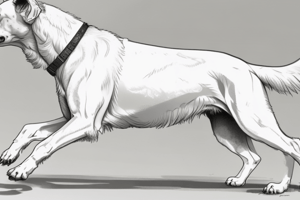Podcast
Questions and Answers
What typically eliminates inter-male aggression in dogs?
What typically eliminates inter-male aggression in dogs?
- Establishing dominance
- Medication therapy
- Enhanced socialization
- Castration (correct)
Which type of aggression can occur naturally in maternal animals?
Which type of aggression can occur naturally in maternal animals?
- Maternal aggression (correct)
- Pain-induced aggression
- Territorial aggression
- Learned aggression
How may pain-induced aggression unintentionally escalate during a dogfight?
How may pain-induced aggression unintentionally escalate during a dogfight?
- By separating the dogs using physical barriers
- By distracting the dogs with treats
- Through increased barking from bystanders
- By inflicting more pain to stop the fight (correct)
What can lead to learned aggression in dogs?
What can lead to learned aggression in dogs?
In which scenario is territory aggression likely to manifest in dogs?
In which scenario is territory aggression likely to manifest in dogs?
What is a common solution for addressing persistent inter-male aggression in male pets?
What is a common solution for addressing persistent inter-male aggression in male pets?
What describes a common misunderstanding about aggression in cats compared to dogs?
What describes a common misunderstanding about aggression in cats compared to dogs?
Which behavior might indicate pain-induced aggression in an animal?
Which behavior might indicate pain-induced aggression in an animal?
What is the most effective solution to reduce urine spraying in male pets?
What is the most effective solution to reduce urine spraying in male pets?
Which of the following may contribute to a dog soiling indoors?
Which of the following may contribute to a dog soiling indoors?
How can submissive behavior in dogs lead to house-soiling?
How can submissive behavior in dogs lead to house-soiling?
What common assumption about female pets and spraying is correct?
What common assumption about female pets and spraying is correct?
Chronic fear can lead to which issue concerning house-soiling in pets?
Chronic fear can lead to which issue concerning house-soiling in pets?
Which of the following is considered a common reason for cats to be relinquished to shelters?
Which of the following is considered a common reason for cats to be relinquished to shelters?
What behavior may indicate a dog is marking its territory rather than having an elimination issue?
What behavior may indicate a dog is marking its territory rather than having an elimination issue?
Confining an animal is often suggested to address which type of behavior?
Confining an animal is often suggested to address which type of behavior?
Which behavioral issue is specifically triggered by an owner's absence?
Which behavioral issue is specifically triggered by an owner's absence?
What is the primary cause of conflict-related aggression in dogs?
What is the primary cause of conflict-related aggression in dogs?
What behavior may indicate a dog suffering from separation anxiety?
What behavior may indicate a dog suffering from separation anxiety?
Which type of aggression is most commonly observed in animal hospitals?
Which type of aggression is most commonly observed in animal hospitals?
What medical condition was indicated by the change in behavior of the neutered poodle?
What medical condition was indicated by the change in behavior of the neutered poodle?
What common misconception might owners have regarding fear-induced aggression?
What common misconception might owners have regarding fear-induced aggression?
Which of the following is a potential sign of canine separation anxiety?
Which of the following is a potential sign of canine separation anxiety?
What type of aggression occurs without warning signs, such as growling?
What type of aggression occurs without warning signs, such as growling?
Which factor might make dogs from shelters more susceptible to separation anxiety?
Which factor might make dogs from shelters more susceptible to separation anxiety?
Which behavior shows a dog using aggression as a means to avoid conflict?
Which behavior shows a dog using aggression as a means to avoid conflict?
Flashcards
Pain-Induced Aggression
Pain-Induced Aggression
Aggressive behavior caused by pain; a protective instinct.
Inter-male Aggression
Inter-male Aggression
Aggression between males of the same species, often driven by testosterone.
Territorial Aggression
Territorial Aggression
Aggressive behavior related to protecting a territory.
Maternal Aggression
Maternal Aggression
Signup and view all the flashcards
Learned Aggression
Learned Aggression
Signup and view all the flashcards
Conflict-Related Aggression
Conflict-Related Aggression
Signup and view all the flashcards
Dogfight Escalation
Dogfight Escalation
Signup and view all the flashcards
Castaion Elimination
Castaion Elimination
Signup and view all the flashcards
House soiling in pets
House soiling in pets
Signup and view all the flashcards
Pet medical issues
Pet medical issues
Signup and view all the flashcards
Marking territory in male pets
Marking territory in male pets
Signup and view all the flashcards
Neutering for pets
Neutering for pets
Signup and view all the flashcards
Insufficient outdoor walks
Insufficient outdoor walks
Signup and view all the flashcards
Submissive behavior issues
Submissive behavior issues
Signup and view all the flashcards
Marking behavior in pets
Marking behavior in pets
Signup and view all the flashcards
Inappropriate elimination (cats)
Inappropriate elimination (cats)
Signup and view all the flashcards
Canine Separation Anxiety
Canine Separation Anxiety
Signup and view all the flashcards
Separation Anxiety Signs
Separation Anxiety Signs
Signup and view all the flashcards
Fear-Induced Aggression
Fear-Induced Aggression
Signup and view all the flashcards
Predatory Aggression
Predatory Aggression
Signup and view all the flashcards
Aggression Types
Aggression Types
Signup and view all the flashcards
Medical Causes in Behavior Changes
Medical Causes in Behavior Changes
Signup and view all the flashcards
Behavior Evaluation
Behavior Evaluation
Signup and view all the flashcards
House Soiling
House Soiling
Signup and view all the flashcards
Underlying medical issue
Underlying medical issue
Signup and view all the flashcards
Study Notes
Pain-Induced Aggression
- Aggressive behavior related to pain is a protective instinct.
- A pet with a painful lesion may have a natural tendency to bite if the lesion is manipulated.
- Pain-induced aggression is one factor that keeps dogfights going.
- When an aggression is a one factor that keeps dogfights going.
- When an injury to a dogfight through punishment, the additional pain inflicted may intensify the fight.
- Problems related to pain-induced aggression can occur when an animal in pain continues the aggression even after the painful stimulus is gone.
Inter-male Aggression
- Male dogs and cats commonly display aggression toward each other.
- This is known as inter-male aggression.
- It's a testosterone-driven natural instinct.
- In rare cases where castration doesn't alleviate the problem, behavioral medication may be recommended.
Territorial Aggression
- Territorial aggression refers to aggressive tendencies related to territory, and it's somewhat different in dogs and cats.
- Dogs tend to be aggressive toward humans who aren't members of their household.
- Cats tend to be aggressive toward other cats in their perceived territory.
- Territorial aggression may cause problems in a household.
Other Aggressive Behaviors
- Maternal aggression is rare but can occur in the post-parturition period (after giving birth).
- This is a normal maternal instinct developed to protect an animal's young from an animal.
- Many other aggression-related problems are learned behaviors.
- Owners sometimes unwittingly reinforce aggressive behaviors.
- For example, if a dog growls at its owner and the owner responds by withdrawing, the dog learns that a growl will chase the owner away.
- Dogs can also be taught to fight on command.
- In another example, a normally well-behaved dog may begin to respond aggressively to a new child or other person in the home.
- This is considered a form of conflict-related aggression.
- One common problem is that owners often reinforce this type of aggression through punishment.
- This can lead to the dog being fearful of the child, and create other aggression problems.
- Learned aggression isn't particularly evident in cats, although it can occur.
Studying That Suits You
Use AI to generate personalized quizzes and flashcards to suit your learning preferences.



